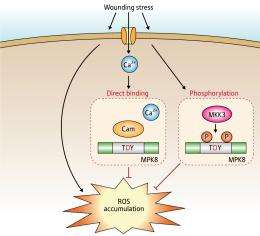Unraveling plant reactions to injury

Better understanding of plant defense systems, and the potential to generate stress-tolerant plants and even new malaria drugs, may all stem from the documentation of a molecular mechanism that plays a significant role in the response of plants to physical injuries, such as cuts. A team of agricultural researchers in Japan, led by Fuminori Takahashi of the RIKEN Plant Science Center in Tsukuba, found that the key protein in the complex mechanism is MPK8, which is fully activated by two signaling pathways working in concert.
The researchers showed that MPK8 is activated while the wounded plant mounts an initial emergency response to an injury. Around the fresh wound, the plant produces reactive oxygen species (ROS), such as hydrogen peroxide. These highly toxic compounds kill any pathogens that could access internal tissues via the wound site. However, since ROS can also harm plant tissue they require close regulation. Takahashi and his team—from RIKEN and three Japanese universities—found that the regulator is MPK8.
In addition to the initial response, the injury stimulates the release of calcium ions and starts a cascade of phosphorylation or phosphate-adding compounds. The compounds involved are called mitogen-activated protein kinases (MAPKs). MPK8 is one of the MAPKs of the model plant Arabidopsis.
Takahashi and his colleagues used Arabidopsis plants to investigate how both signaling and the levels of ROS are regulated after physical injury. Using plants into which they had introduced additional copies of the MPK8 gene, the researchers showed that MPK8 was activated under stress, particularly from physical wounding. MPK8 was strongly activated by MKK3, another MAP kinase from higher up the cascade. But it was also activated by calcium ions, specifically when they were bound to proteins called calmodulins. In addition, the researchers determined that the production of MPK8 was associated with regulation of ROS, lowering its accumulation.
A region of MPK8 known as TDY is known to interact or be phosphorylated with both MKK3 and calcium-bound calmodulins. By inhibiting each of these compounds in turn, the researchers showed that full activation of MPK8 demanded activating both of them at once, bringing the signaling pathways together. Finally, by examining the expression of genes, they found that MPK8 regulates the production of ROS by repressing the gene that stimulates their production (Fig 1).
“We think our findings might eventually lead to designing a drug treatment for malaria infection,” says Takahashi, “because the Plasmodium parasite involved uses the same kind of MAPKs.”
More information: Takahashi, F., et al Calmodulin-dependent activation of MAP kinase for ROS homeostasis in Arabidopsis. Molecular Cell41, 649–660(2011).
Provided by RIKEN



















